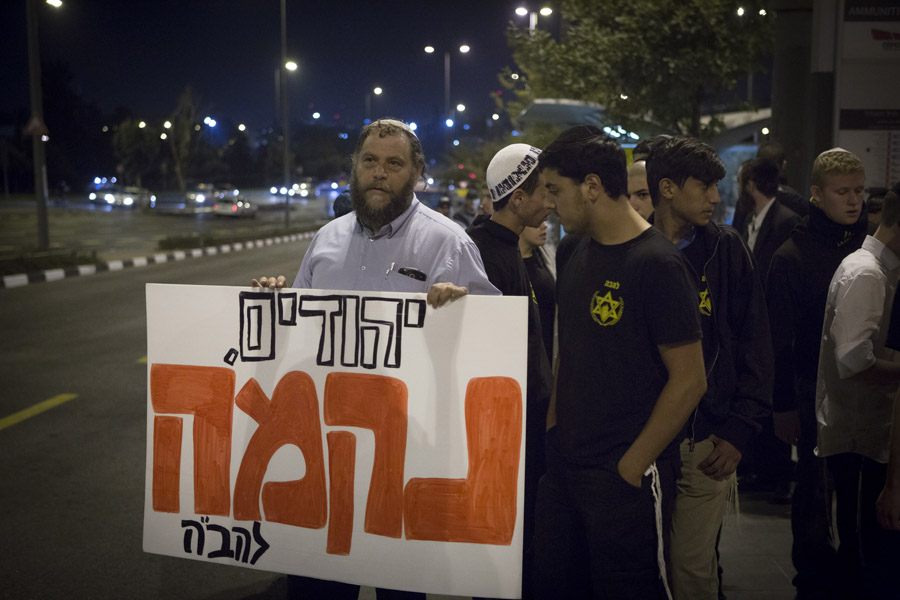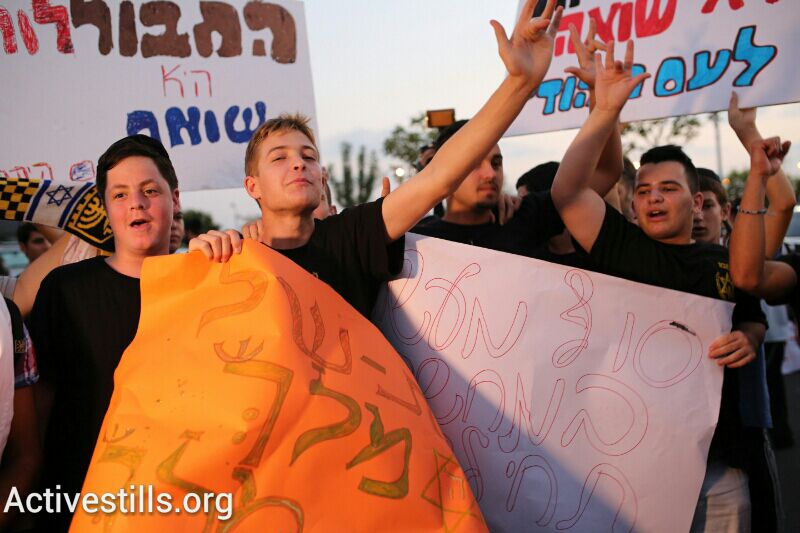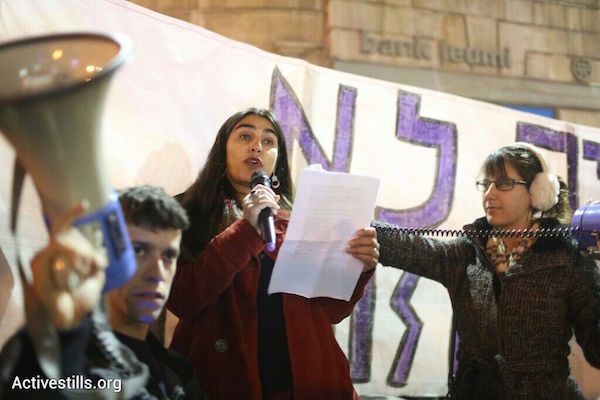They roam the streets looking for either mixed Jewish-Palestinian couples or lone Arabs, protest at mixed weddings, and hand out racist leaflets. Their leaders are militant and well-organized, exploiting disaffected youth to do the dirty work. An inside look at the far-right group, Lehava, and the Jerusalem activists who are trying to put an end to its violence.
By Ossnat Sharon

Outside of Jerusalem, we often hear of Lehava demonstrating at a mixed Jewish-Palestinian wedding, or perhaps the LGBT pride parade. But ultimately, a protest of this sort by a handful of extremists isn’t very harmful. The truly destructive dimension of Lehava’s activities is its integration into Jerusalem’s landscape.
Lehava activists come to Jerusalem’s Zion Square on Thursday nights (and sometimes on Saturday nights) in trademark shirts and with flags, and hand out flyers and stickers to passersby. They are highly visible. Last summer they numbered no more than 10 teens, both boys and girls; this summer they have at least doubled in numbers, and almost all of them are boys. This fits in with the changing nature of their activities, which have become more organized and militant.
Sometimes the activists march down the street, shouting: “Arab, watch out, my sister is worth more!” “The daughters of Israel belong to the people of Israel!” and “Kahane was right!” These marches garner some media attention, and it is easy to track and report them to the police, which is likely the reason we have seen less of them in the past few weeks. But they continue to loiter around downtown Jerusalem in smaller groups that are more difficult to track, often without their identifiable shirts, looking for Arabs.
Lehava activists scout downtown Jerusalem looking for mixed couples, and often simply for Arabs, in order to threaten them. They obviously have a WhatsApp group, and are at their comrades’ beck and call whenever a fight appears imminent. This is an effective way to cleanse the city center of Arabs: these guys are scary.
Ideological youth
Before I get to Lehava’s complex relationship with the law and the police, it is important to understand who its activists are: nearly all of them are teenagers who are usually accompanied by one or two adult supervisors. Their ages range from about 13 to 21. While some come from a normative background, others are youth at risk and many of them spend a great deal of time on the streets. Some of them formerly belonged to the ultra-Orthodox community, some live on the outer edges of Jerusalem, where there is often friction with the eastern side of the city (including stone throwing).
Read: Hundreds rally against racist group ‘Lehava’ in Jerusalem
Our personal conversations with Lehava activists have revealed that many of them work with Arabs, and many report of women they know personally who have had abusive relationships with Arab men. In their own eyes, they are ideological youth serving the greater good while their friends are out partying. Dedicated social workers spend many nights downtown offering at-risk youth thermoses with tea, or hoping to initiate a conversation over a game of checkers. This is all very well, but these teens live the complex and violent politics of the city, and want more than tea or checkers. They are looking for meaning, and Lehava supplies it in spades.
When the leaders disappear
Lehava has an inner circle of activists who wear its shirts, but there is also an outer circle consisting of friends of the activists, who hang around, say hello, and collaborate with them to some degree. The important difference between the circles is the level of discipline of their members: activists who wear Lehava shirts will avoid violence (at least as long as they are wearing them), and will obey the orders of the adult supervisor. These adults are wary — they know the law, and they want to be as effective as possible.
The heads of Lehava are careful to tread the fine line between legal and illegal, between extremism and what is deemed acceptable. They are very consistent in these acrobatics. When speaking to moderate religious Jews, they make an effort — and often succeed — to present themselves as an anti-assimilation group, that seeks to warn young Jewish women about the dangers of abusive romantic relationships with Arabs. Many Jerusalem residents respond to this positively, allowing the activists to transform an ideological-educational discourse into a violent one against Muslims, Christians and leftists.
It doesn’t take much for words to turn into actions: an integral part of the youths’ activities is to find and surround mixed couples, or join altercations with Arab youths hanging out downtown or Arab workers who they claim threaten them. The adult supervisors are also called to these altercations. Lehava takes part in creating violent provocations, which are later described — both within the group and outside it — as “attempted terrorist attacks.”

This is where the “outer circle” comes in. A few weeks ago, we intervened in a case in which a young teenage boy got into an argument with an Arab employee at a local business (perhaps the employee yelled at him or offended him? Perhaps there was some petty theft?). The boy’s friends came to his aid and threatened the employee, and in a matter of minutes Lehava activists had arrived at the scene. At this point, there were dozens of teenagers there preparing for violence. One can see a pattern that begins with a street kid looking for trouble and continues with the involvement of his friends who are more organized and ideological, while at the end of the line are a small group of adults with a violent political agenda, funding and a measure of legal support.
As for the legal front, we have witnessed two tactics Lehava activists employ just as the violence begins: 1. They take off the shirts with the Lehava logo on them; 2. The adult leaders take a step back and disappear from the scene, leaving the teenagers accountable. When the police intervenes, these teens bear responsibility for the people who sent them.
This makes it much harder to tie leaders of the organization directly to violence. The delicate acrobatics between legal and criminal activities, between arguably acceptable values and violence, and between street youth dynamics and racist far-right politics — are both effective and frightening, precisely because of how borderline they are.
And what about the police? There is significant police presence downtown at night, but they will get involved only when directly confronted with physical violence. The police refrain from taking action when it comes to threats, taunts or only the potential of violence. Sometimes a policeman will turn a blind eye, and phoning the police often does little good. Violence will frequently develop quickly and end quickly, which means police officers must be ready and willing to carefully track Lehava activists — and most of all to be familiar with the terrain and its dynamics. Unfortunately, there is no permanent police force patrolling the city center with a feel for what is happening and an ability to act accordingly.
What can be done?
We believe that if the municipality were to decide that Lehava are unwanted on the streets of Jerusalem, police possess the tools to prevent them from acting effectively. A different form of policing could also be useful: Randomly assigned policemen who lack understanding of the situation, are inadequately briefed and whose default is to either ignore events or use excessive violence are unhelpful. A patrolman or two who are intimately familiar with the downtown area, the teens and the dynamics of the city could be far more effective, while also better serving the local community.

In terms of education, we must recognize that this phenomenon rests on teenagers, some of whom spend much of their time in the street. Beyond the needs that welfare organizations are trying to fulfill, these youths yearn to be involved in something meaningful. They are only just discovering politics and social activism, a natural part of their coming of age. But the only ones who take them seriously are a handful of extremists with a simplistic and violent doctrine, who take advantage of these teens and use them for criminal activities. We need to find an alternative.
In the last year, a group called “Medabrim BaKikar” (Hebrew for “talking in the square”), made up of secular, religious, right-wing and leftist residents of Jerusalem meets on Thursday and Saturday nights near Zion Square. We stand by the Lehava activists and keep an eye on them, curbing their attempts at violence as best we can.
They know us, and know that unlike the police — we are watching them closely, and are interested not only in their violence, but also in what surrounds it and leads to it. We also initiate conversations with them and with others who gather in the square. We speak openly and respectfully about politics, beliefs, and identity, and the square fills with small public discussions.
This is responsible citizenship that refuses to let the activists of Lehava hold exclusive control of public space, and we are able to see the change in atmosphere over time. With the help of a few simple and elegant rules, this new, empathetic form of political discourse works surprisingly well, providing a rare opportunity for city youth of different backgrounds to converse in a respectful atmosphere. We welcome all Jerusalemites to join us.
Ossnat Sharon is an activist with Medabrim BaKikar in Jerusalem. This article was first published in Hebrew on Local Call. Read it here.

